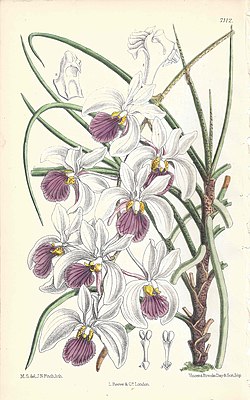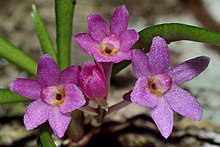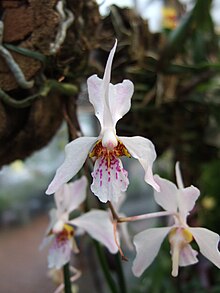Holcoglossum
| Holcoglossum | ||||||||||||
|---|---|---|---|---|---|---|---|---|---|---|---|---|

Holcoglossum kimballianum |
||||||||||||
| Systematics | ||||||||||||
|
||||||||||||
| Scientific name | ||||||||||||
| Holcoglossum | ||||||||||||
| Schltr. |
The genus Holcoglossum belongs to the family of orchids (Orchidaceae) and originates from the tropical to subtropical climates of Asia . The genus today comprises about 23 known species and was established in 1919 by the German botanist Rudolf Schlechter on the basis of Saccolabium quasipinifolium Hayata as a monotypical genus.
description
All species of this genus are persistent epi- or lithophytes and are characterized by a short monopodial stem axis with petiolate or triangular leaves. The upper side forms a groove through folded leaf edges. The leaves are tapered and are not notched at the leaf tip. The root tips of living roots show a reddish color in all species of the genus, and some species have red-spotted leaves. The flowering shoot arises from the side of the stem and forms two or more flowers, these are far apart and form a grape or panicle .
The flowers are white and wide open. The lip is three-lobed. The lateral lobes stand upright and are adaxially spotted. The middle part is spread out over a large area and is parallel to the gynostemium . The lip is shaped to allow potential pollinators to push down the middle lip. The flowers have an elongated spur, which, however , is strongly regressed in the subgenus Brachycentron . The gynostemium has a large area of scarring . The stamen contains two separate porate pollinia. The stalk connecting the pollinia and the adhesive disc (Viscidium) bends in the middle when it is removed from the rostellum. The rostellum is deeply cut. The number of chromosomes in almost all species is 2n = 38. Holcoglossum tsii has 76 chromosomes in the diploid chromosome set (2n = 76).
In Holcoglossum amesianum , self-pollination was observed, in which the pollinium moves independently to the fertile scar in the columna .
distribution
The distribution area of the genus extends over southwest China, Laos, Vietnam, Thailand and Malaysia. Most of the species, however, come from Yunnan Province in the southwest of the People's Republic of China . Holcoglossum quasipinifolium and Holcoglossum pumilum are endemic to Taiwan . The species live at higher altitudes between 1200 m and 3300 m and therefore prefer a cool to cold habitat.
Culture
The small species from this genus can be cultivated in small pots or baskets or tied up on cork plates. Native of cool and damp forests, they require low temperatures and a light location. In the full sun, however, there is a risk of heat accumulation. The plants often need water in the growth phase, in the resting phase less watering is required without letting them dry out. When cultivating in a pot, the substrate should be quite fine in order to be able to feed the tender roots.
The large species of the subgenus Brachycentron and the Holcoglossum section can be cultivated in a tied up, but are best suited for culture in baskets or pots. An exception is Holcoglossum subulifolium , which is better tied up due to its hanging growth. If regular watering is guaranteed, these species are best cultivated in a basket without substrate. Any substrate that is used should be very coarse in structure to allow good air circulation at the roots. The plants need a very bright but also cool location. They should be watered regularly, with drier periods during rest.
In the Jardin Botanique National de Belgique in Meise (Belgium), Holcoglossum kimballianum are kept in an alpine greenhouse in which one's own breath condenses and a parka must be worn. In nature, the plants are regularly exposed to hoarfrost during the flowering period, which they survive without any problems.
A successful culture often fails because the culture is too warm over the long term or because the substrate is too fine and the roots die off due to the lack of air.
species
The following list of species, structured according to subgenus and sections , is based on the questioning system established by Jin.
- Subgenus Brachycentron X.H. Jin & SC Chen
- Holcoglossum amesianum (Rchb.f.) Christenson : Assam to China and Indochina
- Holcoglossum auriculatum Z.J.Liu, SCChen & XHJin : China to Indochina
- Holcoglossum subulifolium (Rchb.f.) Christenson : China to Hainan and Indochina
- Subgenus Holcoglossum
- Section Holcoglossum Christenson
- Holcoglossum kimballianum (Rchb.f.) Garay : China to Indochina
- Holcoglossum lingulatum (Aver.) Aver. : China to northwestern Vietnam
- Holcoglossum omeiense X.H.Jin & SCChen : Sichuan
- Holcoglossum quasipinifolium (Hayata) Schltr. : Taiwan
- Holcoglossum singchianum G.Q.Zhang, LJChen & ZJLiu : Yunnan
- Holcoglossum wangii Christenson : China to northern Vietnam
- Section Holcoglossum Christenson
- Section Sorotylos X.H. Jin & SC Chen
- Holcoglossum flavescens (Schltr.) ZHTsi : China to Indochina
- Holcoglossum nujiangense X.H. Jin & SC Chen : Western Yunnan
- Holcoglossum rupestre (Hand.-Mazz.) Garay : Northwestern Yunnan
- Holcoglossum sinicum Christenson : Northern Yunnan
- Holcoglossum tsii T.Yukawa : Northwestern Yunnan
- Holcoglossum weixiense X.H.Jin & SCChen : Northwestern Yunnan
- Section Sorotylos X.H. Jin & SC Chen
- Not yet assigned
- Holcoglossum calcicola Schuit. & P.Bonnet : Laos
- Holcoglossum gaoligongense (GQZhang, K.Wei Liu & ZJLiu) Kumar & SWGale : Yunnan
- Holcoglossum himalaicum (Deb, Sengupta & Malick) Aver. : Eastern Himalayas to Yunnan and northern Myanmar
- Holcoglossum linearifolium Z.J.Liu, SCChen & LJChen : Yunnan
- Holcoglossum nagalandese X.H.Jin : Assam to China
- Holcoglossum phongii (Aver.) Aver. et O. greeting : Southern Vietnam
- Holcoglossum pumilum (Hayata) LJChen : Taiwan
- Holcoglossum semiteretifolium (Seidenf.) R. Rice : Arunachal Pradesh to northern Thailand
- Not yet assigned
According to the authors, the species Holcoglossum calcicola Schuit & P.Bonnet cannot be clearly classified according to the system established by Jin (2005). The species shows features of both the subgenus Holcoglossum and the subgenus Brachycentron .
Intergeneric hybrids
The following intergeneric hybrids with Holcoglossum are listed with the Royal Horticultural Society .
- × Holcocentrum ( Holcoglossum × Ascocentrum )
- × Holcenda ( Holcoglossum × Ascocentrum × Vanda )
- × Holcosia ( Holcoglossum × Luisia )
- × Holcanthera ( Holcoglossum × Renanthera )
- × Holcodirea ( Holcoglossum × Sedirea )
- × Holcopsis ( Holcoglossum × Vandopsis )
- × Holcostylis ( Holcoglossum × Rhynchostylis )
- × Holcovanstylis ( Holcoglossum × Rhynchostylis × Vanda )
- × Mendelara ( Holcoglossum × Ascocentrum × Neofinetia × Rhynchostylis × Vanda )
- × Vandoglossum ( Holcoglossum × Vanda )
See also
Individual evidence
- ↑ a b Rafaël Govaerts (Ed.): Holcoglossum. In: World Checklist of Selected Plant Families (WCSP) - The Board of Trustees of the Royal Botanic Gardens, Kew . Retrieved April 8, 2020.
- ^ ZH Tsi: A study of the genus Holcoglossum of Orchidaceae. In: Acta Phytotaxonomica Sinica. Peking 20 (4), 1982, pp. 439-444. ISSN 0529-1526
- ^ LA Garay: On the systematics of the monopodial orchids. In: Botanical Museum Leaflets. Cambridge Mass 23 (4), 1972, pp. 149-212. ISSN 0006-8098 .
- ↑ a b X.-H. Jin: The generic delimitation and a new infrageneric system of Holcoglossum (Orchidaceae). In: Botanical Journal of the Linnean Society. Oxford 2005, 149 (4), pp. 465-468, doi : 10.1111 / j.1095-8339.2005.00463.x .
- ↑ X.-H. Jin et al .: Cytological studies on the genus Holcoglossum (Orchidaceae). In: Botanical Journal of the Linnean Society. Oxford 2007, 154 (2), pp. 283-288. doi : 10.1111 / j.1095-8339.2007.00654.x .
- ↑ Ke-Wei Liu, Zhong-Jian Liu et al .: Pollination: Self-fertilization strategy in an orchid. In: Nature. Vol. 441, 2006, pp. 945–46, doi : 10.1038 / 441945a , Orchidee mates on scienceticker.info, accessed on December 31, 2017.
- ^ ZJ Liu, SC Chen, X.-H. Jin: Holcoglossum auriculatum, A New Species of Orchidaceae from China. In: Journal of Wuhan Botanical Research. Wuhan 23 (2), 2005, pp. 154-156. ISSN 1000-470X .
- ↑ X.-H. Jin et al. a: Holcoglossum nujiangense (Orchidaceae: Aeridinae) - a new species and its pollination system. In: Nordic Journal of Botany. Oxford 25 (1-2), 2007, pp. 125-128. doi : 10.1111 / j.0107-055X.2007.00018_25.x .
- ↑ André Shuiteman Pierre Bonnet: . Holcoglossum calcicola and Paphopedilum barbigerum var sulivongii - two attractive new orchids, the limestone mountains of Laos. (PDF; 943 kB) In: Orchideenjournal. 1, Göttingen 2009, pp. 6-14, ISSN 1864-9459 .
literature
- Xiao-Hua Jin, Qin Haining, Chen Shingchi: A New Species of Holcoglossum (Orchidaceae: Aeridinae) from China. In: Kew Bulletin. Vol. 59, No. 4, London 2004, pp. 633-635. ISSN 0075-5974 .
- Xiao-Hua Jin et al: A New Species of Holcoglossum (Orchidaceae) from China. In: Novon. Vol. 14, No. 1, St. Louis Mo., 2004, pp. 178-179, ISSN 1055-3177 .



